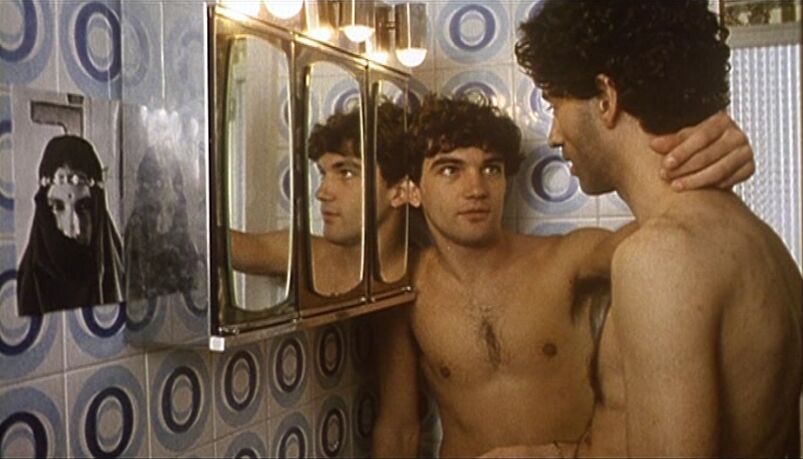
Welcome back to our queer film retrospective, “A Gay Old Time.” In this week’s column, we’re revisiting one of auteur filmmaker Pedro Almodóvar’s earliest feature films, Labyrinth Of Passion, from 1982.
In his more than four decades of career, Spanish director Pedro Almodóvar has become one of the most prominent and unique queer voices in world cinema.
A singular auteur of the melodrama, he has managed to craft a unique marriage of visual style and narrative themes: bright, bold colors and patterns that reflect the vibrancy and passion of his characters, swelling music that underscore the buried emotions, and stories that unapologetically center the desires, fears and struggles of female and queer characters. You know an Almodóvar movie when you see one.
Your dose of fabulosi-TEA
Subscribe to our newsletter for your front-row seat to all things entertainment with a sprinkle of everything else queer.
He’s currently starting production on his newest film The Room Next Door, which will become his first-ever feature film in English, and will star Tilda Swinton and Julianne Moore. It will follow his latest short film, “Strange Way Of Life”, a homoerotic western starring Ethan Hawke, Pedro Pascal, and Manu Ríos, which was shortlisted for the Academy’s Best Live Action Short Film category—though it failed to get a nomination.
With Pedro’s career as busy as it’s ever been, we thought it would be apt to revisit some of his earliest work with 1982’s Labyrinth Of Passion.
Related:
From Rock Hudson to Pedro Pascal: Western movies have always been gay
With ‘Strange Way Of Life,’ the western is having its long-overdue coming out party.
The Set-Up
Labyrinth Of Passion was only Almodóvar’s second feature film, after Pepi, Luci, Bom And Other Girls Like Mom in 1980. The comedy follows the intertwined lives of an eccentric group of characters in Madrid. The main plot revolves around a nymphomaniac pop star (Cecilia Roth), a group of gay terrorists trying to take down a fictional Middle Eastern country, and the undercover prince of that nation (Imanol Arias) who is looking for true love.
As the title might suggest, it’s all a bit convoluted, but it touches on many themes that Almodóvar would explore more deeply later in his career: the role of sex in power dynamics, homosexuality as an act of social defiance, women whose unhappiness and emptiness seem almost chronic and debilitating, and the use of comedy and melodrama to bring out the darkest aspects of human emotion.
It’s a movie in which the characters are unapologetic about their identities and their desires, as taboo as they may appear. This is a movie in which a prince decides to steal the semen of his ex-lover’s son, where a woman openly admits that her father constantly sexually abuses her as if she was recounting what she had for breakfast, and where a young Antonio Banderas becomes obsessed with the scent of his lovers like a bloodhound.
Purposeful Chaos

This sense of cultural trespassing may be the entire point of it all. These characters are guided—and in many ways defined—by the traits that society tries to push away or remove from them. And although he does it much more loudly here, that’s a theme that has chased Almodóvar in film after film.
Similarly, Labyrinth of Passion is stylistically much rougher and unpolished than what his signature aesthetics would become. As opposed to the controlled frames and meticulously crafted mise-en-scène in his more current oeuvre, the camera moves frantically from character to character across crowded rooms.
It feels chaotic at times, with background noise often drowning the rapid-fire dialogue and the story moving at a non-stop pace. But there’s an undeniable energy brimming through it; the eagerness and creativity pouring out of a young filmmaker that hasn’t quite yet mastered how to harness it.
He’s Got The Look

Because even if they may not “look” the same, it’s not hard to trace a direct line from Labyrinth Of Passion to Almodóvar’s later work. The way the characters carry themselves unapologetically and authentically: the sex workers, the homosexuals, the punk rock drag performers (where Pedro himself plays in a cameo), and the everyday women. Almodóvar keeps bringing these characters to the center, and making an argument that their lives are just as interesting and exciting and introspective (if not more) than the types that have taken the spotlight in film for decades.
There are even some sequences and characters that are emulated in his later films. The final confrontation at the airport recalls the final sequence in Women On The Verge Of A Nervous Breakdown. And the last scene of the film—two lovers getting it on in the middle of a flight—is a big narrative aspect of I’m So Excited, which is entirely set on a plane.
And this marks the first of several queer roles that Antonio Banderas would play for Almodóvar—although they vary from the psychotic (Law Of Desire) to the quiet introspection of maturity (Pain And Glory), his boyish charm and erotic appeal is utilized similarly.
Related:
Well Halleloo! Antonio Banderas owes his life to a drag queen
It’s a gay miracle.
Almodóvar’s First Act

It’s always a fascinating experiment to look back at the earliest output from a filmmaker that has worked as consistently as extensively as Almodóvar has. There are clear aspects of his craft that have evolved as his notoriety (and production value and budget) has grown. There’s an undeniable level of polish and visual craft that has become synonymous with his films. However, looking back at a film that lacked that polish and pastel-colored vision, it’s clear that those aren’t the elements that make Almodóvar one of the greatest queer filmmakers.
It’s his commitment and passion for characters and narratives that have been overlooked by the mainstream. It’s his unapologetic use of pastiche and references to those he admires (there is so much of John Waters’ joy and delight in the filthy and the obscene here, for example), and his use of style as a means to reflect the characters’ inner lives. Those elements have never been bound by how manicured a film looks. They have been embedded from the start.
And as he steps into new territory, embracing Hollywood and the English-speaking audiences fully after a few attempts in short form, it will be thrilling to see how his style continues to grow and evolve, and how he will find new ways of coming back to the same themes that have haunted him, now with a brand new set of tools.
Pedro Almodóvar’s Labyrinth Of Passion is currently available for digital rental or purchase via Amazon Prime Video and Vudu.




















Kangol2
I didn’t see this film until after seeing several of the later ones Almodóvar directed a little while after this one (it was just a bit before my time), but it contains so many seeds and early elements of what was to come in nearly all his later films.
He has grown ever more sophisticated as a filmmaker, but he has never lost of his sense of outrageousness, his irony and wit, his fearleessness in confronting what other filmmakers wouldn’t, and a profound queerness that makes his films iconic and unique. And he still gets some of the best actors and knows how to direct them like few other directors can.
Pietro D
I wouldn’t want to see this junk!
DennisMpls
Pietro – Why not? Or, to rephrase, why do you consider it “junk.”
bachy
Love all of Almodovar’s films. Especially exciting watching the development of Antonio Banderas as an actor and as a contemporary sex symbol. You can’t beat these young Spanish boys with their raven hair and caramel eyes.